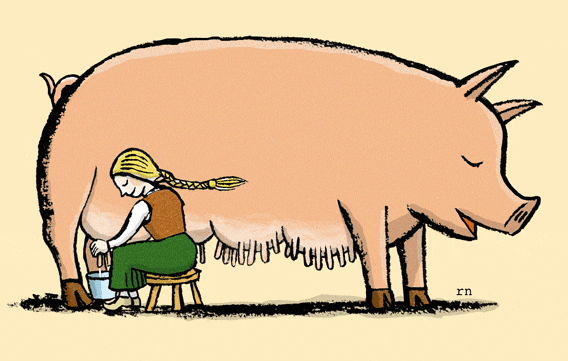So guys, I know topic can be a bit sensitive but I was watching my fave tv show ever QI and they were chatting about what things in everyday life are made from pigs and i found it horrific and wants to educate people on what they are using.
It is not only sweets that contain pork gelatine. In some beers, wines and fruit juices, pig gelatine is used to remove the cloudiness from the drink. It works as a clarifying agent by reacting with the tannins in the liquid and absorbing the cloudiness.
Some ice creams, whipped creams, yoghurts and certain butters also contain gelatine, as do certain pet foods. More surprisingly, a number of medicines also contain pig gelatine - everything from painkillers to multivitamins.
Hygiene and beauty products are also made of pig. Fatty acids extracted from the bone fat of pigs are used in shampoos and conditioners to give them their shiny, pearl-like appearance. These acids can also be found in a number of body lotions, foundations and anti-wrinkle creams. Glycerine made from pork fat is also an ingredient in many types of toothpaste.
Christein, from Holland, found that while some companies were reluctant to cooperate in her quest, others claimed that they didn't even realise their products contained elements taken from a pig because of the middle men involved in the complex distribution process.
The confusion is not helped by the fact that it is not clear on products' ingredient labels where they originally came from.
According to the Food Standards Authority, there is no legal obligation for manufacturers to specify whether the gelatine they use is from a pig or another animal. When it is specified, it is often confusingly referred to as Suilline gelatine.
According to Richard Lutwyche - a British pig farmer with more than 60 years experience, chair of the Traditional Breeds Meat Marketing Company and a member of the British Pig Association - the reasons for much of this confusion is due to the industrial-scale of much pig farming.
'In the UK, big commercial farms send their pigs to large abattoirs. The abattoir will find different markets for all the by-products,' he says. 'Everything they can't sell they have to incinerate, so it's in their best interest to sell as much as they can.
'There's an old expression that says: when it comes to pig, you can use everything but the squeal. Over the past 100 years those uses have expanded rapidly.'
Some of the surprising products that can include pig material include photographic film, which uses collagen from pig bones; shoes that use bone glue from pigs to improve the quality of the leather; and certain paints that use bone fat to enhance their glossy properties.
Some makers of cigarettes use haemoglobin from pig's blood in their filters. Apparently this element works as a sort of 'artificial lung' in the cigarette so, they claim, 'harmful reactions take place before the chemicals reach the user'.
And the next time you buy a loaf of bread you would be well advised to read the packaging. Some manufacturers use an ingredient called L-cysteine, which is a protein made from pig or other animal hair and which is used to soften the dough.
A product like Tesco's Plain Tortilla Wraps includes this ingredient. The strangest use for a pig by-product that Christein found was in bullets and explosives. Pig bone gelatine was used to help transport the gunpowder or cordite into the bullet. It is difficult not to be impressed by the sheer versatility of this animal and its parts.
Virtually nothing in a pig goes to waste.



No comments:
Post a Comment